Notes - ADS HT24, Red-black trees
- [[Course - Algorithms and Data Structures HT24]]U
- https://www.cs.usfca.edu/~galles/visualization/RedBlack.html
Flashcards
What are the the 5 properties of red-black trees?
- Every node is either red or black
- The root is black
- Every leaf (which is always NIL) is black
- If a node is red, both its children are black
- For every node, all simple paths from $x$ to descendant leaves have the same number of black nodes (excluding $x$)
Suppose $x$ is a node in a red-black tree. What is bh($x$), and why is this well-defined?
- The number of black nodes in any simple path from $x$ to descendant leaves, excluding $x$.
- Well-defined since one of the properties of a red-black tree is that this number is the same for all paths.
Quickly prove that a red-black tree $T$ with $n$ items (not including NIL leaves) has a height $\le 2 \log(n + 1)$.
- First, note that height($T$) $\le 2$bh($T$) since for an arbitrary path $P$ from root to a leaf, the number of red nodes in $P$ is less than the number of black nodes in $P$.
- Then, note that bh($T$) $\le \log(n+1)$ since if we collapse every red node to its black parent, the resulting tree has height bh(T). Every node has $\ge 2$ children, but the number of leaves is still the same as the number of leaves in $T$, which is $n + 1$. So $2^{\text{bh}(T)} \le n + 1$, which implies bh($T$) $\le \log(n + 1)$.
The approach for implementing insertion in red-black trees to insert a node $x$ like normal and then fix any violations to the red-black tree properties that we might have created. What type of violation might we create?
A red-red violation between $x$ and its parent.
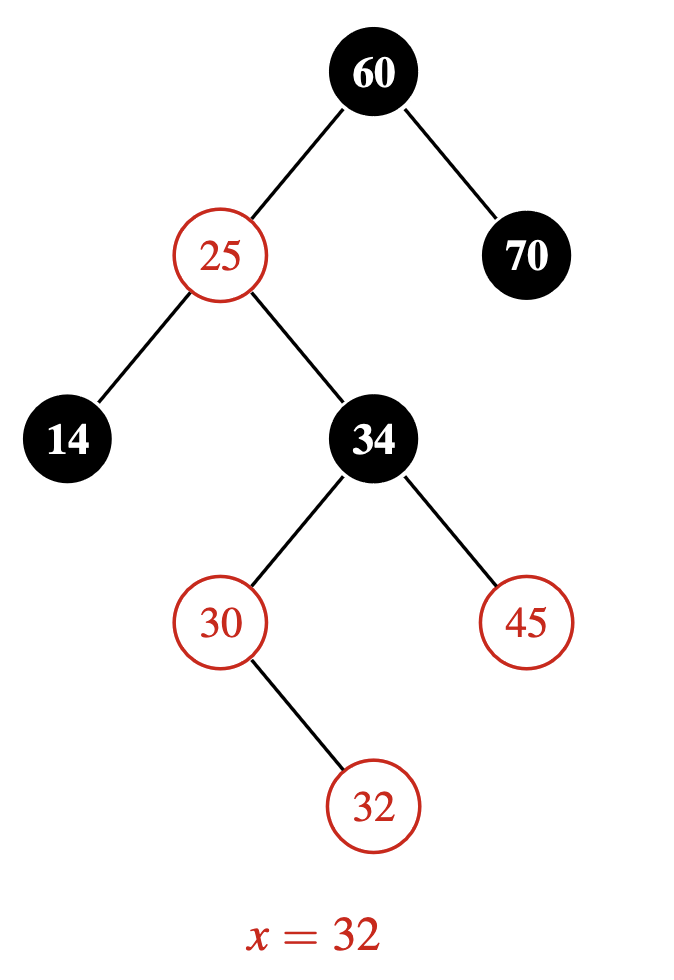
Suppose we have just inserted $x = 32$ into the red-black tree above and have created a red-red violation. What do you call this case, and what approach do we take here to move the violation upwards?

The “funky uncle”. Recolour $p[x]$ and $\text{uncle}[x]$ black, and recolour $p[p[x]] = \text{grandparent}[x]$ red.
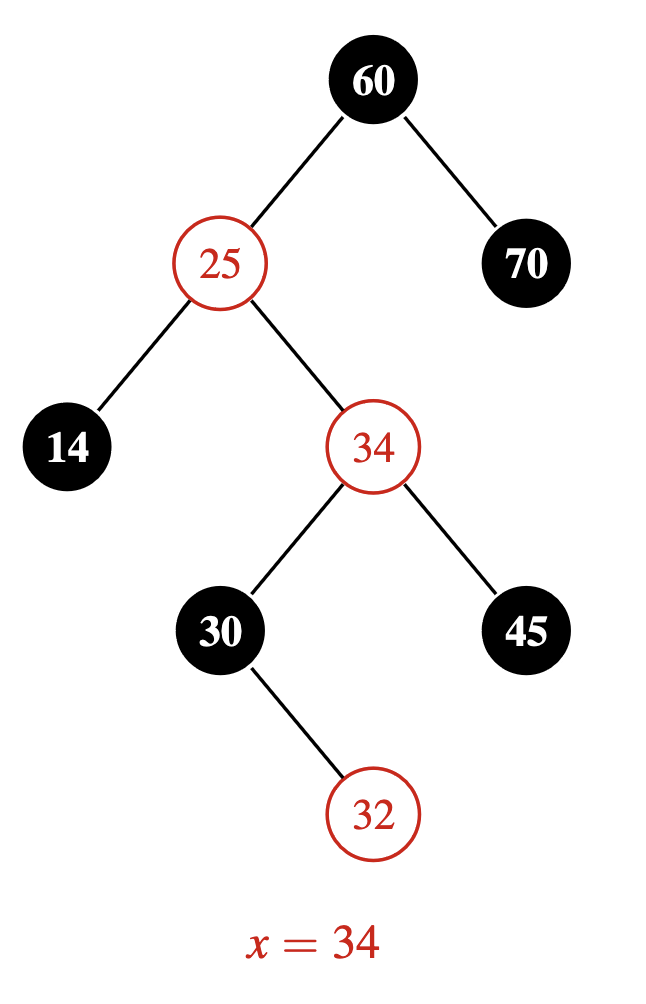
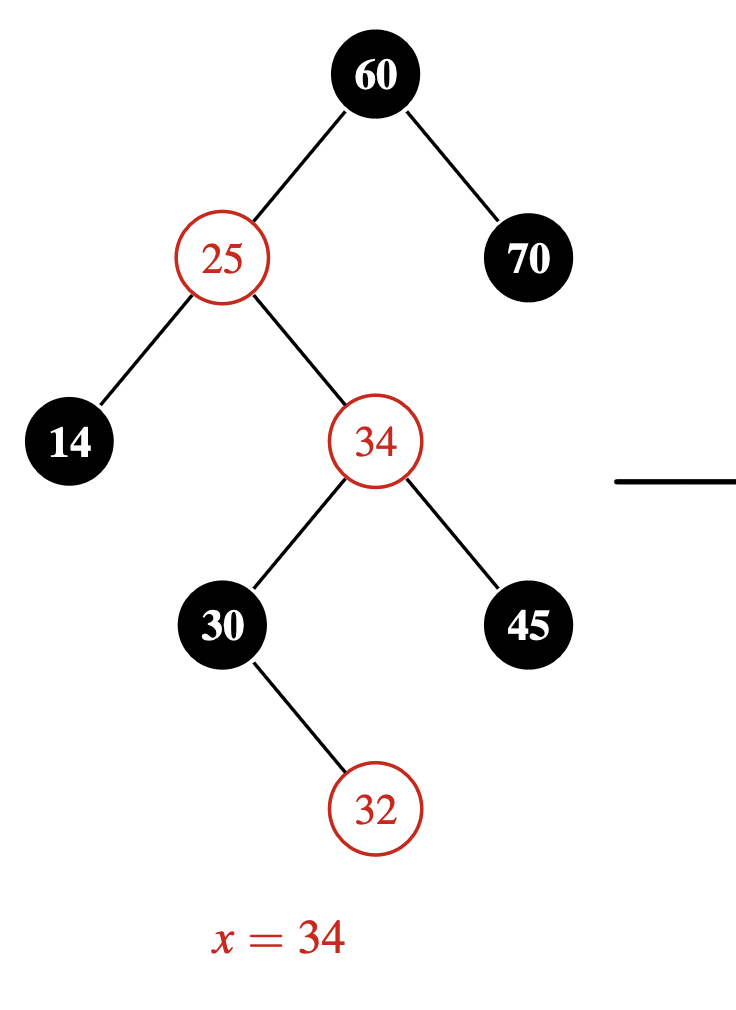
We’re in the process of fixing a violation after inserting $32$ into a red-black tree. Here we are now focussed on fixing the red-red violation between $x = 34$ and $p[x] = 25$. What do you call this case, and what do you do to move the violation upwards?

This is the “zig-zag” case, since $x$, $p[x]$ and $p[p[x]]$ form a zig-zag shape. Here you rotate $x$ with $p[x]$ to form
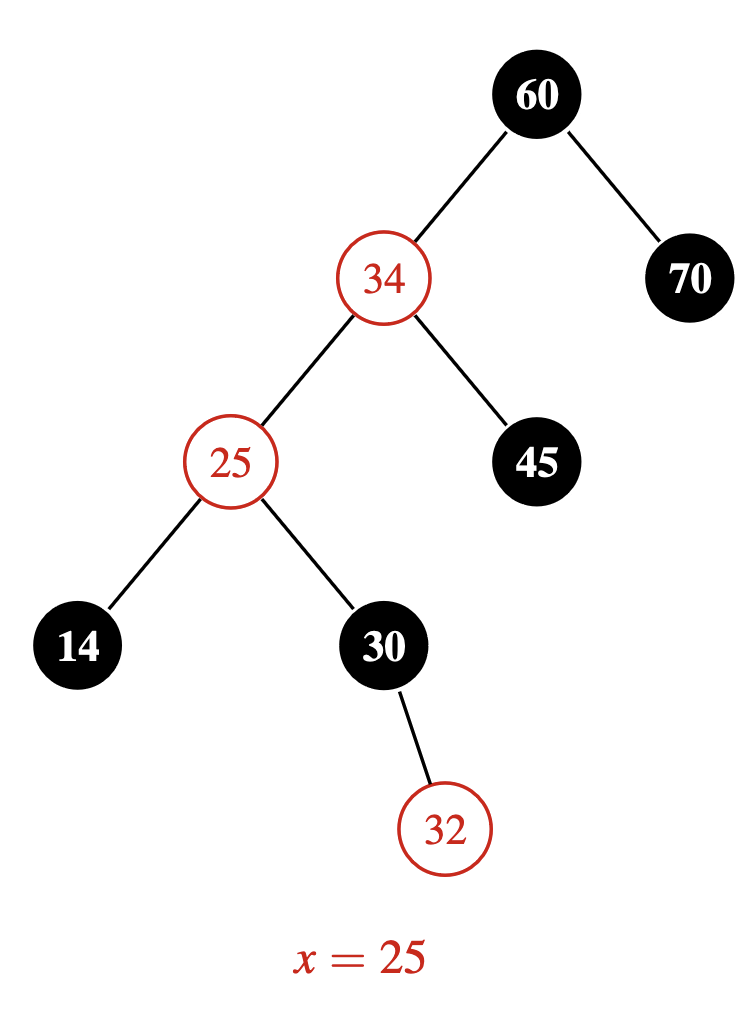
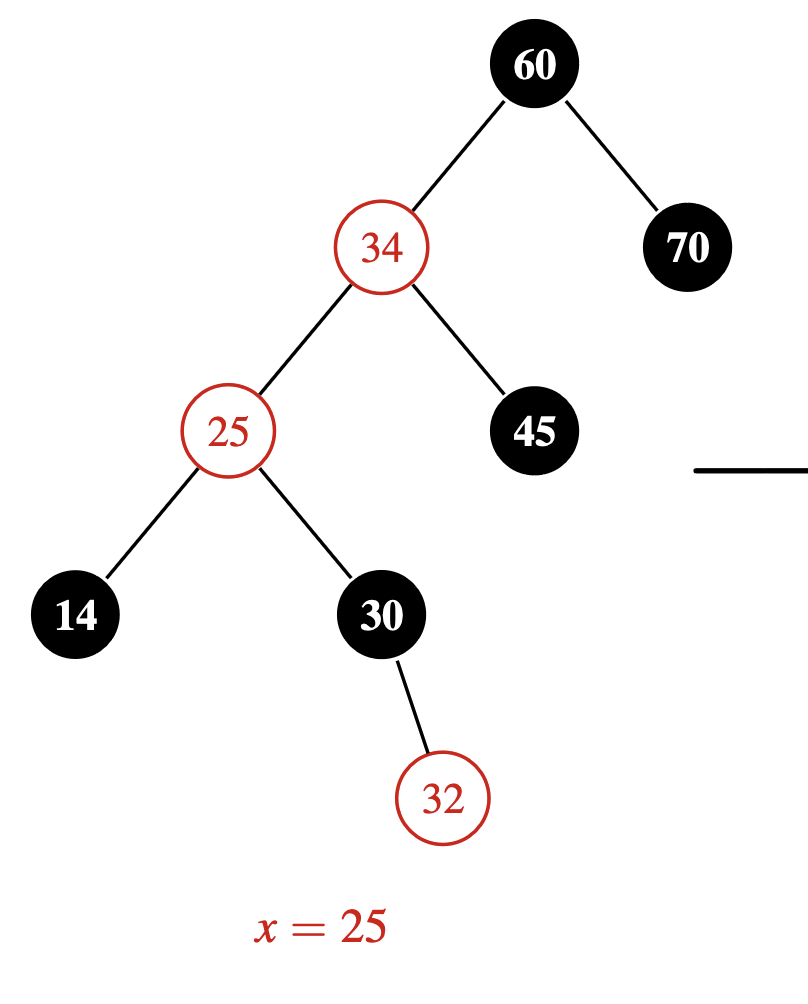
We’re in the process of fixing a violation after inserting $32$ into a red-black tree. Here we are now focussed on fixing the red-red violation between $x = 25$ and $p[x] = 34$. What do you call this case, and what do you do to move the violation upwards?

This is the zig-zig case, since $25, 34$ and $60$ form a straight line. This you fix by switching the colours of $p[x]$ and $p[p[x]]$ and then rotating $p[x]$ with $p[p[x]]$.
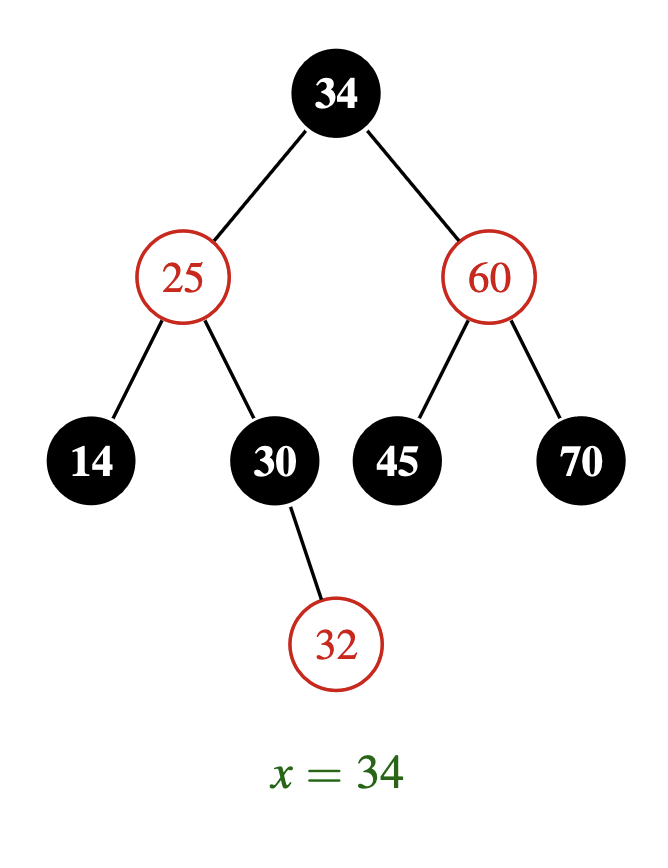
What are the three cases that might occur when fixing violations in a red-black tree (just the names).
- Funky uncle
- Zig-zag
- Zig-zig
Give the pseudocode for $\text{RBInsert}(T, x)$, which inserts a value $x$ into a red-black tree. You can use Insert($T$, $x$) for normal binary search trees as a subroutine, and for each of the three cases in the main loop, don’t go into too much detail but briefly describe how you’d “move the violation upwards”.
RB-INSERT(T, x):
INSERT(T, x)
colour[x] = red
while x != root(T) and colour[x] = colour[p[x]] = red:
y = uncle[x]
if colour[y] = red:
# the "funky uncle case"
keep x red
recolour p[x] and uncle[x] black
# now violation is between p[x] and p[p[x]]
else:
if x - p[x] - p[p[x]] is not aligned:
# the "zig-zag case"
rotate x with p[x]
else if x - p[x] - p[p[x]] is aligned:
# the "zig-zig" case
rotate p[x] with p[p[x]]
recolour p[p[x]] black (was originally p[x])
recolour p[x] red
colour[root[T]] = black
The pseudocode for inserting an element into a red-black tree is as follows:
RB-INSERT(T, x):
INSERT(T, x)
colour[x] = red
while x != root(T) and colour[x] = colour[p[x]] = red:
y = uncle[x]
if colour[y] = red:
# the "funky uncle case" (case 1)
keep x red
recolour p[x] and uncle[x] black
# now violation is between p[x] and p[p[x]]
else:
if x - p[x] - p[p[x]] is not aligned:
# the "zig-zag case" (case 2)
rotate x with p[x]
# this reduces it to case 3
else if x - p[x] - p[p[x]] is aligned:
# the "zig-zig" case (case 3)
recolour p[x] black
recolour p[p[x]] red
rotate p[x] with p[p[x]]
# this terminates the algorithm
colour[root[T]] = black
Quickly prove that this algorithm terminates, and in fact does so in $O(\log n)$ iterations of the while loop.
RB-INSERT(T, x):
INSERT(T, x)
colour[x] = red
while x != root(T) and colour[x] = colour[p[x]] = red:
y = uncle[x]
if colour[y] = red:
# the "funky uncle case" (case 1)
keep x red
recolour p[x] and uncle[x] black
# now violation is between p[x] and p[p[x]]
else:
if x - p[x] - p[p[x]] is not aligned:
# the "zig-zag case" (case 2)
rotate x with p[x]
# this reduces it to case 3
else if x - p[x] - p[p[x]] is aligned:
# the "zig-zig" case (case 3)
recolour p[x] black
recolour p[p[x]] red
rotate p[x] with p[p[x]]
# this terminates the algorithm
colour[root[T]] = black
It helps to draw a picture of each case:
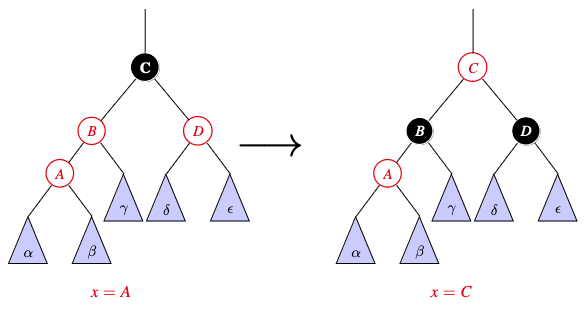
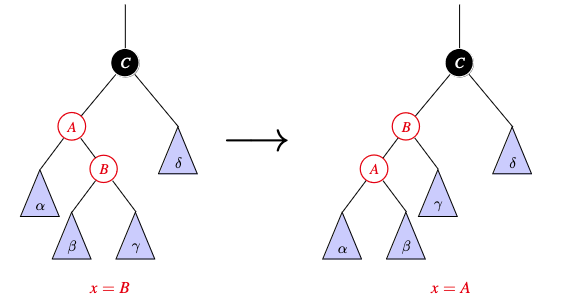
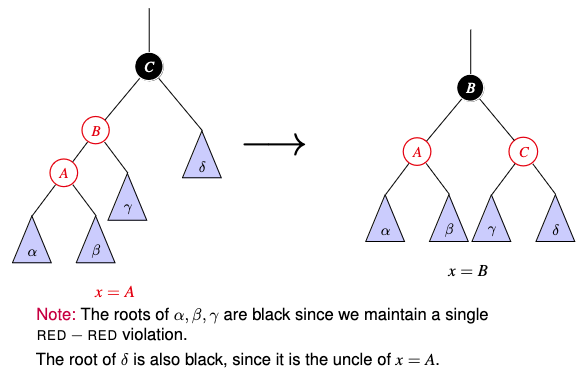
Note that:
- Case 1 propogates the red-red violation further up the tree
- Case 2 converts the tree into one with case 3
- Case 3 ends the algorithm, as there is no longer a red-red violation.
Hence the worst case is if case 1 is repeated over and over. Since a red-black tree with $n$ items has height $O(\log n)$, this case can only occur $\log n$ times, and so the algorithm must terminate after $O(\log n)$ steps.
Draw the “funky uncle” case of insertion a red-black tree and then describe and draw the fix.

- Invert the colours of $p[x], \text{uncle}[x], \text{grandparent}[x]$
Draw the “zig-zag” case of insertion into a red-black tree and then describe and draw the fix.

- Rotate $x$ with $p[x]$.
- (Note this doesn’t move )
Draw the “zig-zig” case of insertion into a red-black tree and then describe and draw the fix.

- Rotate $p[x]$ with $\text{grandparent}[x]$ and recolour.
Assuming that we’re considering a chain of nodes $x$, $y$, $z$ decreasing in depth in a binary tree, complete the following table for how splay trees / red-black trees handle different cases in their algorithms.
Case (down) / Alg (across)
Splay trees
Red-black trees
Funky uncle
…
…
Zig zig
…
…
Zig zag
…
…
For the specific case of red-black trees, also highlight how each case affects how “close we are” to fixing the red-red violation.
In splay trees, we are interested in moving the element we’re splaying up through the tree. In red-black trees, we are interested in fixing a the red-red conflict.
| Case (down) / Alg (across) | Splay trees | Red-black trees |
|---|---|---|
| Funky uncle | N/A | Recolour, red-red conflict has moved upwards |
| Zig zig | Rotate yz, then xy | Rotate yz, recolour, we are done |
| Zig zag | Rotate xy, then xz | Rotate xy, reduces to zig zig |
We have the following partial table of what steps to perform in either a splay tree or a red-black tree in any given situation:
Case (down) / Alg (across)
Splay trees
Red-black trees
Funky uncle
N/A
Recolour, red-red conflict has moved upwards
Zig zig
Rotate yz, then xy
…
Zig zag
Rotate xy, then xz
…
Given the description of the steps that need to be performed for the splay tree, what’s an easy way to remember the steps that need to be performed for red-black trees?
It’s the first rotation and then a recolour, so:
- Zig-zig: rotate yz
- Zig-zag: rotate xy
In red-black trees, how can you remember whether to recolour the nodes in the zig-zig or zig-zag steps?
Rotate, recolour any nodes in order to fix the violation, and then make sure the black height is still the same.